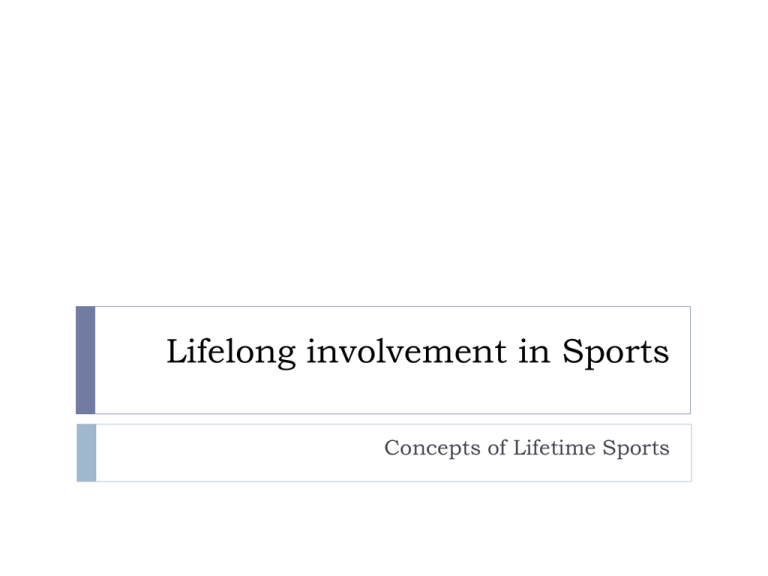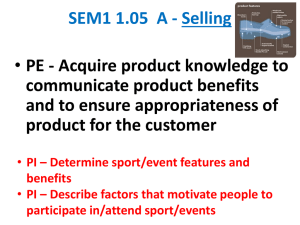Lifelong involvement in Sports
advertisement

Lifelong involvement in Sports Concepts of Lifetime Sports Mass Participation The benefits of mass participation are both intrinsic and extrinsic. INTRINSIC Promotes mental health Promotes physical health Positive use of spare time EXTRINSIC Healthy people mean less strain on the health system. Crime and antisocial behaviour is reduced Economic benefits Mass Participation - Constraints Some people suffer constraints that prevent them from taking part in sport. The aim of mass participation is to break through these constraints so as many people as possible participate. Constraints on Participation Age Gender Disability Ethnicity Social class Mass Participation - Constraints TARGET GROUPS – is a group identified by sport England as needing special attention to raise participation levels. These groups have certain factors in common in that they are subordinate to the dominant group in society. Consequently they share similar problems in participating in sport or physical recreation. Target Groups Women Low income Ethnic minorities Very young Very old disabled Mass Participation - Opportunity In the UK most sport takes place in clubs on a voluntary basis. It is mainly elite as fees have to be paid or as in some cases e.g. Golf clubs you have to be nominated to join. This limits membership to a few only. Mass Participation Time Women face difficulty due to having both work and family constraints. Having to work long hours in certain jobs or shift work can also reduce how much time is available . Provision Not all areas have suitable facilities available. Some sports require expensive equipment. Mass Participation Esteem Some find it difficult to participate due to views and judgement of society. In some cultures women are discouraged to participate. Some believe that if women do participate it should be in a “feminine” sport. Stereotypes and Myths Some minority groups are labelled as having certain characteristics and are therefore steered into some sports and away from others. E.g. Black men can’t swim, white men can’t jump, Asians can’t play football Mass Participation Peer Pressure Children will conform to stereotypes. They are influenced greatly by their friends. This is highest in early teens which coincides with when key choices are made. Geographical Factors The distance from facilities or natural resources needed to participate in a particular sport will determine what activity is chosen and how often they participate. Mass Participation – Educational factors Most learn to play a sport at school. Therefore the type of experience one gets from school physical education will influence their choice in adulthood. Team games tend to dominate PE curriculums. The introduction of schemes such as sport education helps raise and keep interest in senior school. School facilities are being opened up to the public resulting in more access to sport facilities. Mass Participation – Reformative Policies Making England Active – aims to help people of all ages start and stay active in sport. Multi Sport Hubs – development of community sports facilities that offer multiple activities as well as educational, social and health services. Active Places Initiative – web based resource that allows people to search for facilities in their area. Public Service Agreements – agreements between various agencies to increase participation in sport in different areas. Mass Participation – Specialist Agencies Women’s Sport Foundation - charity that campaigns to make physical activity an everyday part of life for women and girls. (http://wsff.org.uk) The English Federation of Disability Sport (EFDS) - a charity responsible for the promotion and development of sporting opportunities for all disabled people in England. (http://www.efds.co.uk/) Kick it Out - football's equality and inclusion campaign. It works throughout the football, educational and community sectors to challenge discrimination, encourage inclusive practices and work for positive change. (http://www.kickitout.org/) Mass Participation – other schemes Concessions – special prices at sports facilities for target groups Local Schemes – different local authorities have set up schemes tailored to their areas. Many have a referral system from the doctor’s surgery coinciding with specialised schemes to get people involved and active. School and county sports partnerships – Develop and streamline a localised network of clubs, coaches, volunteers and competitive opportunities. Lifetime Sports Some sports can be pursued throughout life e.g. badminton, golf. This is because they are self paced, which means that they can play at their own level or energy output. The concentration can also be on fun and enjoyment rather than competition. One belief is that school s should introduce lifetime sports into the curriculum so that the interest can be carried into adulthood. However in most schools they follow the National Curriculum which bis domintaed by invasion games. Leadership and Volunteering Performers need, coaches, administration, officials, leaders if they to participate. Sport England found that to promote participation it must encourage volunteers to do these jobs. Approximately 1.2 million people regularly coach sports in the UK and there are 6 million sport volunteers also. These are usually non qualified and unpaid individuals. Leadership and Volunteering There are various schemes available which help train volunteers. The Sports Leader Award is aimed at school and college students and gives them the necessary skills to lead groups. Step into Sport was established by The Youth Sport Trust in partnership with Sport England and Sports Leaders UK to give 14-16 year olds opportunities to get involved with leadership and volunteering






